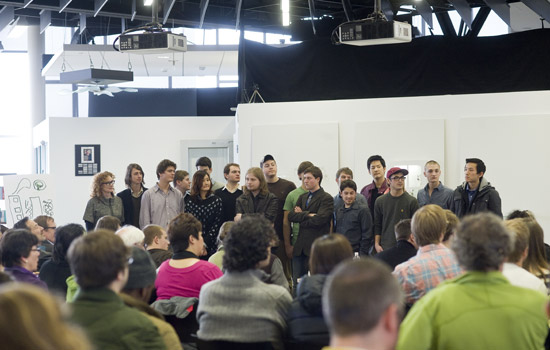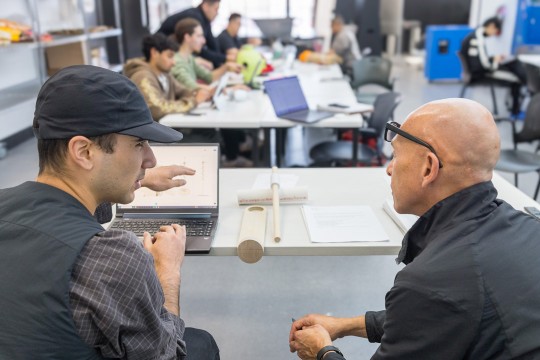Live from New York: It’s Metaproject
Design project opens the door for students at Design Week in New York City
A. Sue Weisler
Students involved with RIT's Metaproject, seen here during a recent exhibit on campus, displayed their work at Wanted Design, an international design event, during Design Week in New York City. The exhibit provided many opportunities for industrial design and glass students involved in the project. The project partnered glass and industrial design students with Corning Museum of Glass on a design project that utilized glass as the primary material.
Students from RIT absorbed as much of Design Week in New York City as possible—and Design Week absorbed them.
“I ran out of business cards,” says Dan Ipp, a fourth-year industrial design student whose project won in the industrial design category of Metaproject 02. “We’re meeting a lot of great people who are interested in the project.”
Saturated by designers, industry leaders, the movers and shakers in the design world, the Wanted Design, an international design event, played host to RIT’s Metaproject 02 during Design Week May 18-22.
RIT’s Metaproject 02, in its second year, is a unique project that partnered students from industrial design and glass programs with Corning Museum of Glass to explore design concepts that exploit glass as the primary material. And in a large brick building, formerly a shipping yard terminal, in Manhattan’s Chelsea neighborhood, hundreds walked the bustle—all putting their eyes on the project plopped dead center in the middle of the building.
“Wanted Design really represented the finger on the pulse of what’s going on in contemporary design,” says Michael Rogers, glass professor at RIT. “It just doesn’t get any better than that.”
The design world was abuzz during Design Week and students received much praise and interest from all corners of the design world. Several students even received interest from designers and business owners to put their design into production.
Design Within Reach buyers talked with students in the booth with great interest in several pieces from both glass and industrial design students. Barney’s NYC approached Namdoo Kim, a glass student, to consider production of his iPod dock and speaker design. Guo Wei Chen, an industrial design student, made contact with several architectural companies looking to use his applied technology in his illuminating panel titled “Fireflies” that used LEDs in glass to give the appearance of floating lights or fireflies.
“Over the coming days students will be following up with the hundreds of design-world contacts they made, and several are already booking travel back to New York City for job interviews,” says Josh Owen, industrial design professor and creator of Metaproject.
Designers from all over the world visited the exhibit, but it was a pair of special visitors on Friday that really had the students buzzing. World-renowned designers Massimo and Lella Vignelli visited the student exhibition, greeting each student with smiles. Massimo Vignelli served as a judge, working closely with the students during the design process. He took time to talk to students individually about each project.
“Massimo Vignelli’s participation as a juror for the project was profoundly impactful,” Owen says.
Not only did the students have the opportunity to interact with world-renowned designers, representatives from Corning Museum of Glass were camped out near the project exhibit all weekend. The project has opened a door for students into the world’s most prominent glass museum.
“The relationship with Corning was fantastic and will continue,” Owen says. “The overall partnership opened many doors for students by showing them as the experts they are in defining problems and enriching culture with their products and stories.”
The professional experience will remain with students forever, says Owens. And the students agreed.
“It gave me a good view on the actual design world,” says Allyson Klopp, a first-year graduate student in the glass program. “It gave me a good professional experience.”
The exhibit and endless list of opportunities the students received were the results of a lot of sweat and elbow grease. The project took the students more than 20 weeks to complete. Hours of endless design work and production kept the students focused on the payoff. After the exhibit they packed up their work and headed home—but it clearly was not the end.
“When we put the last piece on the truck and sent it back to Rochester and patted each other on the back, that was the culmination,” Rogers says. “The opportunities are exactly what you want for your students.”



